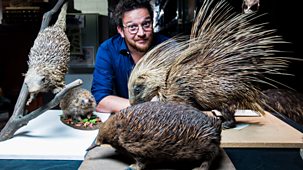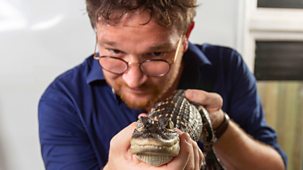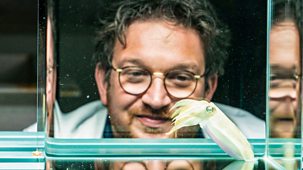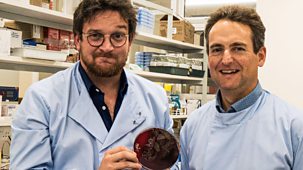
Series 1: 1. Adaptability
Skin is an incredible, multi-function organ that science is still learning so much about. It has adapted to allow animals to conquer virtually every habitat on the planet. \n\nIn this episode, Professor Ben Garrod reveals some ground-breaking new science and amazing, specialist, factual insight as he discovers how human skin is an ecosystem in its own right, playing host to demodex mites, that might redefine our understanding of human ancestry. He explores the new science that could pave the way for re-engineering human skin on amputations to make it more robust. And he reveals how keratin, a protein that is a key component of skin and that makes up our hair and nails, has been taken to the extreme by some animals including pangolins and horses. \n\nSkin is the body’s largest organ and all vertebrates share the same basic blue print. Adaptations in the three main layers, the epidermis, the dermis and the subcutaneous fat layers have allowed vertebrates to thrive in virtually every habitat on earth.
Source: BBC 4
Most recent episodes of Secrets of Skin
Secrets Of Skin
Series 1: 6. Sensing
Professor Ben Garrod explores how some snakes can see using heat, how crocodiles feel through their jaws and how some animals use electricity to navigate their world - and it is ...
03-08-2023
BBC 4
Secrets Of Skin
Series 1: 5. Defence
What is the most toxic animal on earth? How are porcupine quills helping us in medicine? Why is a rhino armour plated, and it is not to protect them from lions? \n\nProfessor Be ...
02-08-2023
BBC 4
Secrets Of Skin
Series 1: 4. Communication
Why are male mandrill faces (big bold primates from West Africa) red and blue? How are birds' feathers so colourful? What do ringtail lemurs do to talk to one another? Their ski ...
01-08-2023
BBC 4
Secrets Of Skin
Series 1: 3. Protection
How does a giraffe stay cool? What are different porcupine quills teaching us about medicine? What makes some people more likely to be bitten by mosquitoes than others? All the ...
31-07-2023
BBC 4
Secrets Of Skin
Series 1: 2. Moving
What makes sharks built for speed? How do snakes move without limbs? How do sugar gliders fly without feathers? The answer all lies in their skin. \n\nProfessor Ben Garrod uncov ...
27-07-2023
BBC 4
Secrets Of Skin
Series 1: 1. Adaptability
Skin is an incredible, multi-function organ that science is still learning so much about. It has adapted to allow animals to conquer virtually every habitat on the planet. \n\nI ...
26-07-2023
BBC 4
Most popular episodes of Secrets of Skin
Secrets Of Skin
Series 1: 3. Protection
How does a giraffe stay cool? What are different porcupine quills teaching us about medicine? What makes some people more likely to be bitten by mosquitoes than others? All the ...
31-07-2023
BBC 4
Secrets Of Skin
Series 1: 4. Communication
Why are male mandrill faces (big bold primates from West Africa) red and blue? How are birds' feathers so colourful? What do ringtail lemurs do to talk to one another? Their ski ...
01-08-2023
BBC 4
Secrets Of Skin
Series 1: 1. Adaptability
Skin is an incredible, multi-function organ that science is still learning so much about. It has adapted to allow animals to conquer virtually every habitat on the planet. \n\nI ...
26-07-2023
BBC 4
Secrets Of Skin
Series 1: 2. Moving
What makes sharks built for speed? How do snakes move without limbs? How do sugar gliders fly without feathers? The answer all lies in their skin. \n\nProfessor Ben Garrod uncov ...
27-07-2023
BBC 4
Secrets Of Skin
Series 1: 5. Defence
What is the most toxic animal on earth? How are porcupine quills helping us in medicine? Why is a rhino armour plated, and it is not to protect them from lions? \n\nProfessor Be ...
02-08-2023
BBC 4
Secrets Of Skin
Series 1: 6. Sensing
Professor Ben Garrod explores how some snakes can see using heat, how crocodiles feel through their jaws and how some animals use electricity to navigate their world - and it is ...
03-08-2023
BBC 4






